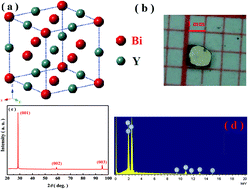Extremely large magnetoresistance in the nonmagnetic semimetal YBi†
Abstract
Extreme magnetoresistance in nonmagnetic compounds has received considerable attention because this phenomenon challenges the classical understanding of electron transport under a magnetic field. In this study, YBi, which crystallizes in a NaCl-type structure, was synthesized via self-flux method to study its magnetotransport properties and electronic structure. Under zero magnetic field, metallic behavior was observed in the whole temperature interval ranging from 2 to 300 K. Interestingly, extreme magnetoresistance and a resistivity plateau developed when the applied magnetic field was increased; the magnetoresistance reaches 0.8 × 105% at 9 T and 2 K. Multiple bands including one electron pocket and two hole pockets revealed by Kohler's rule and first-principle calculations were responsible for the transport processes. Moreover, the hidden band inversion was also uncovered, which suggests the existence of a topological nature in this compound. The contribution of a single Fermi pocket and the combination thereof for magnetotransport indicate that electron–hole compensation plays an important role in determining the electric properties. All these results point towards YBi being a semimetal member of the RPn family (R = rare earth; Pn = Sb and Bi).



 Please wait while we load your content...
Please wait while we load your content...